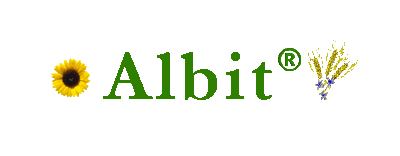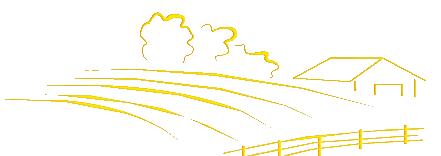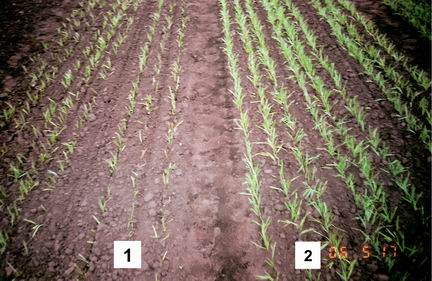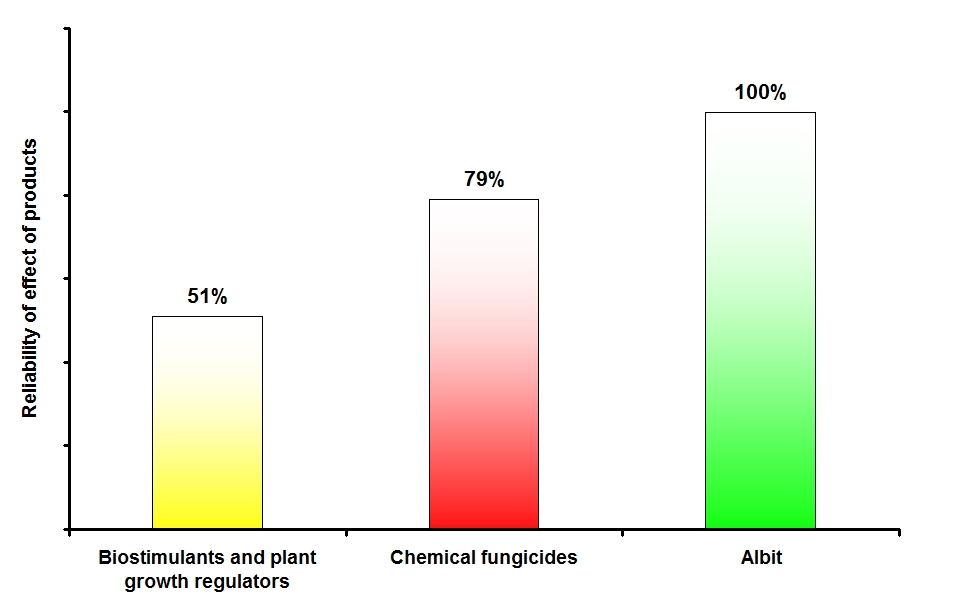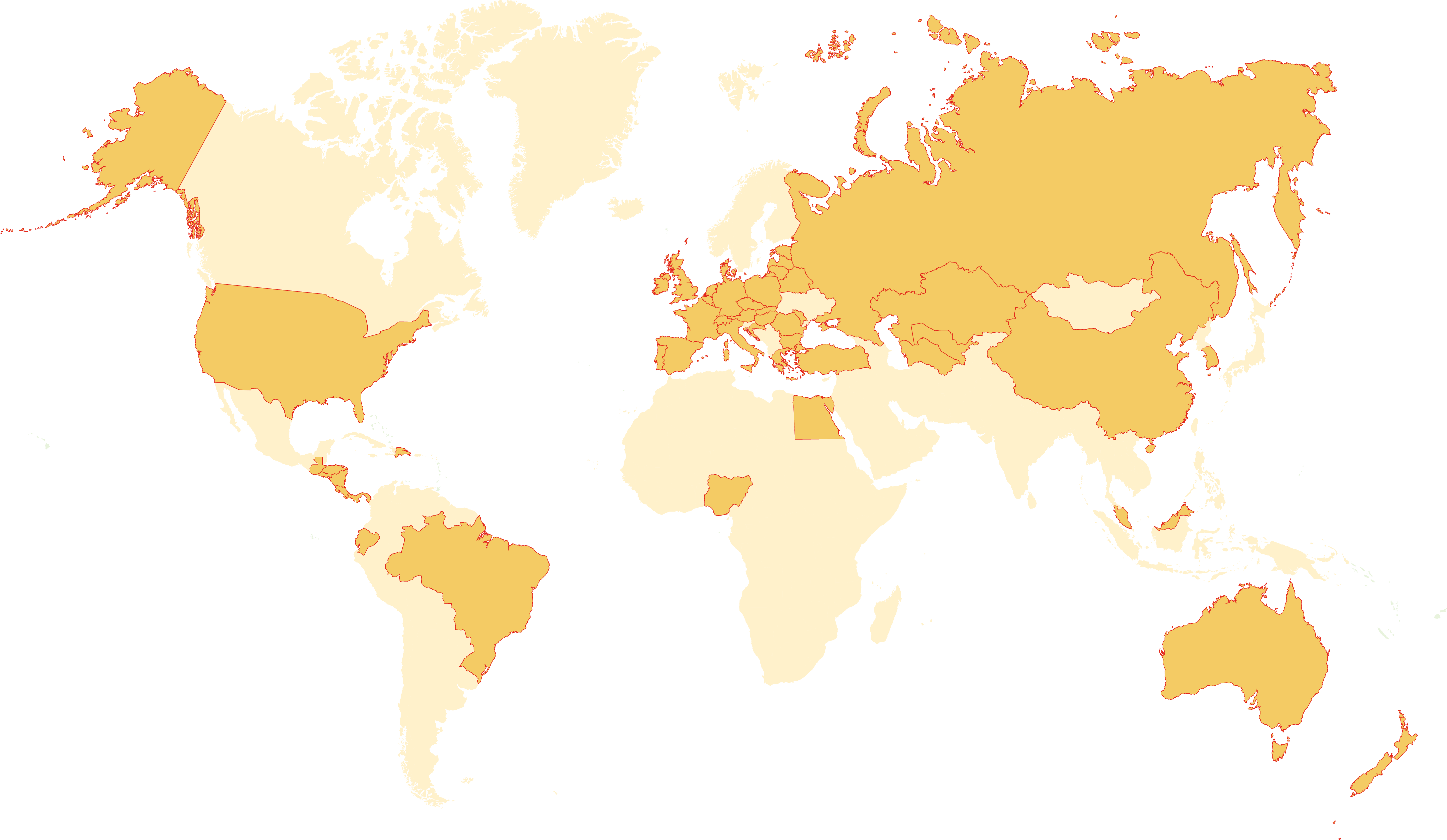|
|
ALBIT:
Fig. 1. Average yield increase (t/ha) obtained with Albit treatment in Russian Federation (crops are given in alphabetical order)
Albit® is an innovative product designed for the ultimate protection of crops against stresses. This bioproduct has diverse functions. Albit increases drought tolerance, as well as tolerance to other unfavourable environmental conditions (stress) in crops; it relieves pesticide stress and harmful effects of chemicals and fertilizers; increases field germination rate; reduces crop production cycle; increases yield (from 5 to 30% depending on the crop); improves product quality (gluten content in wheat on average by 1.6 absolute %, 2.3 % to control, marketability of potatoes, vegetables, and fruits); protects crops from diseases (such as root rots, leaf spot diseases, powdery mildew, rust, late blight, bacterial diseases). Adding Albit into tank mix ensures a reliable, boosted, and stress-free action of pesticides in a wide range of phytosanitary, soil, agrochemical and weather conditions (Fig. 2).
Fig. 2. Comparative efficacy of chemical pesticides and their tank mixes with Albit (schematically according to all conducted field trials)
Our biostimulant is the plants stimulant of biological origin which is developed by Russian scientists and competitive with the best analogues up-country and abroad. In the last decade, Albit becàme the standard for its class of biopesticides in crop production. What is the reason for the success of Albit? A significant drawback of traditional pesticides is their inability to protect plants from abiotic stresses. All huge arsenal of plant protection methods existing now aims to combat diseases and pests (usually causing yield losses in the range of 15-30 %). Meanwhile, the yield losses of major crops occurring due to abiotic stress factors (drought, extreme temperatures soil pollution, pesticide stress, etc.) are estimated at 51-82 %, which is greater than the losses due to pests and diseases (Biochemistry and molecular biology of plants / Eds. B.B. Buchanan, W. Gruissem, R.L. Jones. – American Society of Plant Physiologists, 2006). In particular, any pesticide treatment of plants has a stress side effect even on main culture. Under the influence of herbicides net photosynthetic rate is reduced by 44-100 %, fungicides - by 21-35 %, insecticides - by 36-81 % (Pesticide Biochemistry and Physiology, V. 86 - 2006). Albit LLC employees develop biological stimulators and immunizators for over 40 years. They created a multipurpose antistress agent, using the potential of natural beneficial microorganisms that live on plant roots. Unlike many analogues, Albit has no direct stimulatory effect on the growth, but enhances the natural immunity and stress tolerance of plants, thereby increasing yield.
Fig. 3. Brand-new automatic fermentation equipment which Albit is produced on
High efficiency of Albit has been confirmed in more than 250 successful field trials carried out in 1997-2004 by leading scientific institutions: Lomonosov Moscow State university, All-Russia Institute of Plant Protection (Ministry of Agriculture), All-Russia Institute of Plant Protection RAAS (Russia Academy of Agricultural Sciences), All-Russia Flax Institute, All-Russia Institute of Legumes and Groat Crops, All-Russia Institute of Horticulture, All-Russia Institute of Vegetable Selection and Seed Breeding, All-Russia Institute of Viticulture and Vine processing, Institute of Plant Physiology (Russian Academy of Sciences), All-Russia Soil Institute, Agricultural Scientific Institute of South-East, Ryazan State Agricultural Academy, Kurgan Institute of Grain Growing, Far East Institute of Plant Protection, Institute of Biochemistry and Physiology of Microorganisms, Regional Plant Protection Stations and others. High efficiency of Albit was demonstrated in long-term field trials in winter and spring wheat, barley, rye, oats, rice, sugar beet, sunflower, corn, flax, potato, millet, sorghum buckwheat, soybean, pea, vetch, galega, canola, string bean, lupine, alfalfa, lentil, vine, apple, white and Chinese cabbage, onions, carrots, tomatoes, cucumbers, pepper, lettuce, eggplants, vegetable marrows, table beet, strawberry, currant, cherry, gooseberry, roses, roses, amaranth, decorative green plantings and wood breeds, lawn grasses, outdoor and greenhouse flowers (totally on 70 agricultures). In Russia, Albit is permitted for use as antidote (also registered as a plant growth regulator and fungicide). Albit is registered in a number of countries of the Commonwealth of Independent States, European Union, Switzerland, Australia, Ñhina, USA and other countries, as fertilizer (supplementary additive for plants).
Fig. 4. On the left: Phase-contrast microscopy of bacteria (Bacillus megaterium) with granules of poly-β-hydroxybutyrate (PHB). On the right: structural formula of the PHB.
The active ingredient of Albit is a natural biopolymer poly-β-hydroxybutyrate (PHB) synthesized by soil beneficial bacteria Bacillus megaterium and Pseudomonas aureofaciens. In the natural environment, these bacteria inhabit on plant roots and stimulate root growth, protect plants from diseases and environmental stresses. The formulation also contains a set of substances which potentiate and stabilize the effect of PHB: Magnesium sulphate, Dipotassium phosphate, Potassium nitrate, Urea, and Coniferous extract. Albit does not contain living microorganisms, that makes its activity more stable and less dependent on environmental conditions. Albit combines low cost and low toxicity of biological fertilizers, and efficiency, stability and predictability of chemical pesticides. Mechanisms of action of Albit are based on natural resistance reactions of plants: stimulation of antioxidant enzymes and induction of immune response, regulation of uptake of nutrients and plant development (see for details). Reduce of the chlorophyll content is observed in plant leaves as a result of stress effect of herbicide. It results to decrease of yield (so-called ‘herbicide hole’). Albit, as effective antidote, neutralizes stress effect of herbicides, increases the chlorophyll content. For example, changes of chlorophyll content in leaves of wheat after herbicide treatment was observed in field trials of Penza State Agricultural Academy (Fig. 5).
Fig. 5. Effect of herbicide and Albit on the chlorophyll content in leaves of spring wheat var. Tulaikovskaya 10 (left) and winter wheat var. Bezenchukskaya 380 (right) (Penza State Agricultural Academy, 2011-2012)
This effect was observed on the photo (Farm Zihelsky Statek, a.s., Plzen, Czech Republic, 2011) (Fig. 6). Left – field treated with herbicide (control); right – field treated with tank mix of herbicide + Albit. In variant with Albit, yield was higher than in control by 1.3 t/hà (antidote effect 37%).
Fig. 6. Effect of Albit on growth of barley var. Sebastian. Field after herbicide treatment (left) and tank mix of herbicide + Albit (right) (Farm Zihelsky Statek, Czech Republic, 2010)
Increase of yield and plant growth stimulation. Albit stably increases yield of cereals, sugar beet, sunflower, potato, flax, vegetables, legumes, horticultures, fodder grasses averagely by 5-20% (Plant protection and quarantine, Nr 9, 2005). The yield increase of plant species having high undisclosed potential (such as buckwheat and canola) might reach up to 50 % over the control (Fig.1). On average, based on data of all conducted field trials, one liter of Albit helps obtain the additional yield of winter wheat (5.6 t), spring barley (4.3 t), potato (7.6 t), seed of sunflower (4.1 t), grains of maize (4.5 t), rape (3.2 t). In field trials Albit provided averagely 2.25 times higher yield increase than other biostimulants and plant growth regulators. Effectiveness of Albit was practically the same as that of chemical fungicides, which are tenth times more expensive. Yield quality. Various stresses often reduces crop quality. Albit increases gluten content in wheat by 1.6 abs. %, sugar content in sugar beet on average by 0.3-2.5 abs. %, oil content in canola by 0.2-3.6 abs. %. After Albit treatment, fraction of commercial yield of potato tubers increases up to 34% over control. Fraction of commercial yield of grapevine increases by 10-25%, organoleptic characteristics and flavour of grapes are improved, losses of flavouring and aroma are decreased by 75% during storage, residual amount of pesticides decreases on average by 50%. In vegetables vitamin content increases by 6–25%, nitrate content decreases by 16–26%. In field trial, conducted in experimental station ACPEL (France), among all tested plant growth regulators and fungicides, only Albit increased fraction of commercial yield of melons. Also, Albit reduces of mycotoxin content in grain crops by 20-70%. Protection against diseases. Albit possesses protective activity, suppressing development of the broad range of main diseases of agricultural crops (root rots, powdery mildew, leaf spots, brown rust, fusarioses, septorioses, anthracnose, scab, late blight, black leg, white and grey decay, bacterioses, etc.); Albit is officially registered in Russia as a mean of protection against 26 diseases. Biological efficiency of the pesticide against diseases is 40-90% averagely (Plant protection and quarantine , Nr 1, 2005, Zemledeliye, Nr 1, 2007). Efficiency of Albit against many diseases is not inferior to that of much more expensive chemical means of protection. E.g., the biological efficiency (BE) of Albit against root rots of cereal crops is 59–81% averagely, whereas BE of chemical fungicides is just 40-70% (Plant protection and quarantine , Nr 3, 2005). Unlike chemical fungicides, Albit is not toxic and does not eradicate pathogens, but it increases the natural resistance (immunity) of plants. Therefore, plants should be treated before appearance of the first signs of disease, and infestation with complex of pathogens must not exceed 30% (in absence of internal infections). At higher infestation level, the biostimulant is recommended to combine (mix together) with chemical fungicides. When combined with chemical fungicides, Albit can increase their effectiveness. For example, biological effectiveness of a chemical fungicide is 60% due to the direct biocidal action. When Albit is used together with the fungicide, biological effectiveness reaches 100%. This occurs because of the additional immunization ensured by Albit. Thus, Albit works to secure the full protection of crops against diseases. Albit differs from chemical fungicides by another unique feature. Albit affects not only the plant, but also a huge (tens of billions of microorganisms per gram of soil), diverse microbial world, living on its roots. Chemicalization of agriculture using intensive technology destroys the natural microbiocenosis capable of protecting plants from phytopathogens. Pesticides inhibit microbial activity of the soil by 30-50% (Plant Protection and Quarantine, ¹12-2014). Albit recovers natural community of beneficial microorganisms on the roots of plants (Zashchita i Karantin Rastenij (Plant Protection and Quarantine), ¹9-2011). Treatment with Albit reduces the number of pathogenic microscopic fungi (e.g., the genus Fusarium) in soil at the root by 25-75%. Instead, Albit induces the reduction of pathogenic fungi (for example Fusarium species), and increase the number of usefull micromycetes (Gliocladium and Trichoderma) – antagonists of plant pathogens by 20-150%. As a result, the possibility of infection of plants by soil pathogens reduces. Traditional chemical fungicides are very different. Usually they are able to protect seed against root rot infection reliably. However, the result of the pesticide stress is increased sensitivity of seedlings to secondary infection from the soil, while Albit provides more complex and long-term protection regardless of the infection type (seed or soil). Reduction of fungicidal load. Treatment of plants with the majority of chemical pesticides causes stress and temporary oppression of the plants, negatively affecting yield and yield quality. Albit relieves the fungicide-mediated stress, and also increases natural protective mechanisms of plants against diseases, that lead to increasing fungicidal activity of a chemical pesticide. Therefore, use of chemical fungicides mixed with Albit makes possible application of the lowest recommended fungicide rates. Trials of All-Russia Institute of Biological Plant Protection, All-Russia Institute of Plant Protection RAAS, All-Russia Institute of Plant Protection, Agricultural Scientific Institute of South-East, and other authorities (252 field trials with chemical fungicides and protectants based on benomyl, dimethomorph, dithianon, difenoconazole, carbendazim, carboxin, mancozeb, metalaxyl, propiconazole, sulphur compounds, spiroxamine, tebuconazole, thiabendazole, thiram, triadimenol, flutriafol, copper compounds, cymoxanil, cyproconazole and epoxiconazole) demonstrated that halved dose of a chemical fungicide in combination with Albit is as effective as the full dose of fungicide (Zemledeliye, Nr 2, 2005) For example, trials of All-Russia Institute of Legumes and Groat Crops (Oryol oblast) demonstrated high efficiency of spring barley presowing treatment with combination of Albit and decreased dose of flutriafol/thiabendazol based fungicide (Vestnik RAAS, Nr 2, 2007). Treatment with such combination provided considerable acceleration of plant growth and 28.9% yield increase over untreated control (in variant with full dose of fungicide yield increase was just 17.1%), and total suppression of root rots (Fig. 7).
Fig. 7. Growth of spring barley var. Vizit after pre-sowing seed treatment with fungicide (1) and fungicide + Albit (2) (National Institute of Legumes and Groat Crops, 2005 — left picture, and 2006 — right picture)
Owing to reduction of the dose of chemical fungicides and fungicidal seed treatment agents, Albit make possible considerable reduction the cost of plant protective treatments (by 20-45%). Relieving herbicidal stress. Besides their main functions (protection of plants from weeds), pesticides always cause stress to plants which they are devoted to defend. Antodotes are applied for reducing the toxical stressful effect on plants. Antidotes – compounds that reduce or completely remove the phytotoxic effect of herbicides on cultivated plants and do not effect on herbicidal properties. Not every plant growth stimulator may act as antidote, and this is the fundamental difference Albit from most of analogues. Application of Albit as an safener together with herbicides saves up to half of the yield of cereals, sugar beet, soybean, flax and other cultures. Antistress activity of Albit is especially pronounced in case of winter cereals treatment in EC stage 20-29 (tillering). The plants, weakened by winter, herbicides and root rots, respond to Albit treatment with dramatic increase of productivity (up to 10 centners/hectare under field conditions). In field trials, application of Albit together with herbicides provided considerable yield increase of all major crops. Sometimes chemical antidotes (such as anhydride of naphthalene-1,8-dicarboxylic acid, cloquintocet-mexyl, isoxadifen-ethyl, mefenpyr-diethyl) are initially included by manufacturers in preparative form of pesticides. However, this phenomenon is rarely observed. Most of modern antidotes are narrowly specific in relation to a specific herbicide or preparative form of concrete manufacturer. At the same time, Albit has a wide spectrum of action. To date, the antidote effect of Albit has proven in a combination of our product with herbicides based on 2,4-D, amidosulfuron, haloxyfop-P-methyl, desmedipham, dicamba, quizalofop-P-tefuryl, clopyralide, metsulfuron-methyl, tralkoxydim, triasulfurone, tribenuron-methyl, trifluralin, triflusulfuron-methyl, phenmedipham, fenoxaprop-P-ethyl, florasulam, fluazifop-P-butyl, quizalofop-P-ethyl, chlorsulfuron, ethofumesate and other a.i. (data of more than 120 field trials). In addition, in most of field trials (more than 95%), Albit did not reduce the effectiveness of herbicides against weeds – this is the main requirement for antidotes. For example, trial of Orenburg State Agrarian University demonstrated that Albit increases effectiveness of all herbicides commonly used in this region (Fig. 8).
Fig. 8. Efficiency of combined application of Albit and herbicides
on spring wheat
By now, the antidote activity of Albit was has been proven in combination with herbicides based on 2,4-D amidosulphuron, haloxyfop R-methyl, desmedipham, dicamba, quizalofop-p-tefuryl, clopyralid, metsulfuron-methyl, tralkoxidim, triasulfuron, tribenuron-methyl, trifluralin, thriflusulphuron-methyl, phenmedipham, fenoxaprop-ethyl, florasulam, fluazifop-p-butyl, quizalofop-p-ethyl, chlorsulfuron and ethofumesate (data of 105 field trials). In a similar way, due to its antidote activity, Albit applied together with insecticides against plant louses, leaf beetles, Swedish fly, Colorado beetle, caterpillars and other insect pests increases plant productivity by 5-93% over control (treatment with insecticide alone). It is known that treatment of wheat by insecticides against shield-backed bugs reduces accumulation of gluten in grain. Addition of Albit to the insecticides increases gluten content by 1.2–4.6% comparing to the treatment with insecticide alone. Combination of Albit and insecticides provides pronounced positive effect also on canola. (Plant protection and quarantine, Nr 8, 2007). In summary, combined use of Albit with fungicides, insecticides and herbicides increases their efficiency by 5 - 93 %. According to head of one of the advanced farms-consumers of Albit , only together with Albit all fungicides he used before started working with their full capacity, i.e., providing 100% of the effect declared by their producers. Thus, joint use of Albit and standard recommended means of plant protection provides their high reliability and effectiveness. According to averaged data of all field trials, addition of Albit to chemical pesticides provides yield increase:
Drought resistance. According to data of Institute of Plant Physiology, Albit increases ability of plants to endure drought (increased temperature and moisture deficiency) by 10-60 %. Now Albit is the only pesticide officially registered in Russia as a mean of increase of drought resistance of cereal crops (The List of Pesticides…, 2006). Increased drought resistance remains for several months after treatment with Albit. Due to Albit, at the time of drought in 2003, farmers of Krasnodar krai harvested high yields of wheat and barley (50-70 centners/hectare), same as those level of normal 2002. The analogous effect was observed in the 1998, 2000, 2003 and 2007 drought years in different regions of Russia. The most clearly the effect of Albit on drought resistance of plants is detected on olive trees. When growing on boghara, olive trees are constantly in conditions of severe drought. Spraying with Albit helps plants to retain moisture and form a good yield (Fig. 9). The yield increase was 200% to control.
Fig. 9. Influence of Albit on ability of olive trees to form crop on boghara in dry conditions. Control (standard protection system without Albit), 2 and 3-fold sprayings with Albit (cooperative Olivarera Nuestra Senora de Gracia SCA, Benameji, Andalusia, Spain, 2017) Acceleration of plant growth. Due to intensification of physiological and biochemical processes, Albit accelerates the changes of phenological stages of agricultural crops by 3-12 days. As a result, duration of the vegetative period required to obtain the high-grade yield is reduced, that in some cases makes possible earlier harvesting and obtaining of stable yield of southern cultures (sugar beet, soybean, winter canola, vegetables) in more northern regions (Plant protection and quarantine, Nr 11, 2005). Effect on soil microflora. Often necessary minerals present in soil in the sufficient amount, but these elements are not available for plants. For example, the assimilation of phosphorus from fertilizers is only about 20%. Soil microorganisms, inhabiting the rhizosphere and soil around the plant (soil microbial community), can significantly increase the availability of inorganic nutrients by the release of phosphorus, potassium and microelements from the soil insoluble salts and fertilizers, and nitrogen fixation. When injected into the soil (eg as a result of seeds treatment) Albit is able to stimulate useful soil microflora, which is a unique feature that differs Albit from analogues. By the words of agronomist from the Krasnodar kray of Russia, due to application of pesticides soil becomes almost sterile. Instead, under the Albit action soil bacteria grow and develop actively. In total, microelements supply of plants increases, infectious background decreases, and altogether soil becomes healthier (Zashchita i Karantin Rastenij (Plant Protection and Quarantine), No.9 – 2011). Due to stimulation of diazotrophs, phosphates-solubilizing bacteria and other bacteria in the soil, Albit increases mineral nutrients availability for plants from the soil and fertilizers by 18-47%. According to the Department of Agricultural Chemistry of Moscow State University, Albit application allows to reduce the introduction of mineral fertilizers by 10-30%. Albit could substitute up to 18 kg of active ingredients of nitrogen fertilizers or 14 kg of phosphorous fertilizers for medium-cultivated soils (Bulletin of Research Institute of Fertilizers and Agrochemistry, ¹ 113 – 2000). By the words of agronomist from the Krasnodar kray of Russia, due to application of pesticides soil becomes almost sterile. Instead, under the Albit effect soil bacteria grow and develop actively. In total, microelements supply of plants increases, infectious background decreases, and altogether soil becomes healthier ( Zashchita i Karantin Rastenij (Plant Protection and Quarantine), No.9 – 2011). Due to stimulation of diazotrophs, phosphates-solubilizing bacteria and other bacteria in the soil, Albit increases mineral nutrients availability for plants from the soil and fertilizers by 18-47%. According to the Department of Agricultural Chemistry of Moscow State University, Albit application allows to reduce the introduction of mineral fertilizers by 10-30%. Albit could substitute up to 18 kg of active ingredients of nitrogen fertilizers or 14 kg of phosphorous fertilizers for medium-cultivated soils (Bulletin of Research Institute of Fertilizers and Agrochemistry, ¹ 113 – 2000). From data of Moscow State University and All-Russian Research Institute of Floriculture and Subtropical Crops, treatment with Albit induces the reduction of pathogenic fungi (Fusarium and Phytophtora), and increase the number of micromycetes Gliocladium and Trichoderma – antagonists of plant pathogens. Several parallel mechanisms of action allows Albit guaranteed to have a positive effect on crops. Reliability. Experts in agriculture know well, that the result of application of even highly effective pesticides can noticeably vary depending on year, field specificity, agricultural background, phytosanitary conditions, terms of treatment. One of the purposes of Albit development was overcoming of low reproducibility, which is a common defect of most of the biostimulants. Reproducibility can be quantitatively characterized by the ratio of standard deviation of all experiments and the arithmetical mean (variation coefficient CV). According to averaged results of all field trials, CV of Albit is 52%, biological products and plant growth regulators (without Albit) – 130%, synthetic chemical fungicides – 59%. Therefore, the ability of Albit to provide stable yield increase (reciprocal value for CV) was 2 times higher than that of the other analogues and 26% higher than that of chemical standards. Therefore, high reliability and reproducibility (Fig. 10) is one of the main advantages of Albit. The director of the Chuvashia Research Institute of Agriculture noted: "We at our institute experienced many growth regulators and settled on Albit. Among its counterparts, it has the highest quality and stable action from year to year, regardless of the conditions of the season. At present time, all the plots of the Institute are treated with Albit as an addition to the standard schemes of plant protection."
Fig. 10. Reproducibility of action of Albit and other types
of pesticides (averaged results of all field trials).
Economical efficiency. The result of a low price is the high profitability of Albit (Table 1). For example, the payback of Albit application on winter wheat in Russia is ca. 7,1 times, profitability – 609%. In multiple trials conducted on the main agricultures in Russia, in average the profitability of Albit was not lower than 200 %, payback was 3-15 times according of the year and culture. Cost effectiveness of Albit was 1.89 times higher then chemical fungicides and 2.25 times higher then analogous biopesticides and growth regulators. Net income from the use of Albit in the Krasnodar kray according to the long-term data of Russian Agricultural Center (Rosselhoztsentr) on sugar beet was 3220-4020 rubles / ha, payback from 12.7 to 23 times. In the EU, the net profit from the use of Albit on cereals and oilseed rape was an average of 100 euros / ha.
Table 1. Approximate application recommendations and profitability of Albit for the main agricultures (mean data of all available field trials)
Albit requires very low application rates. For foliar spraying on most agricultural crops, concentration of Albit 1 ml/10 l is recommended. Albit solution of this concentration is used for foliar sprayings, watering, root and extra-root fertilizing, trickle irrigation, soil saturation. It is desirable that the solution gets onto the plant leaves. Instead of performing separate treatments with Albit, you may add 10 ml Albit/10 l working solution of standard herbicide, insecticide, fertilizer treatments (for details see above). Since 1997, Albit has been successfully used in farms of Amur, Belgorod, Bryansk, Vladimir, Volgograd, Vologda, Voronezh, Ivanovo, Irkutsk, Kaluga, Kemerovo, Kirov, Lipetsk, Moscow, Nizhniy Novgorod, Novosibirsk, Omsk, Orenburg, Oryol, Penza, Perm, Rostov, Ryazan, Samara, Saratov, Sverdlovsk, Tambov, Tomsk, Tula, Tyumen, Ulyanovsk, Chelyabinsk, Yaroslavl oblasts, republics of Tatarstan, Bashkortostan, Chuvashia, Kabardino-Balkaria and Mordovia, Altay, Krasnodar, Perm, Primorye and Stavropol krais (totally in 50 regions of Russia and 25 foreign countries ranging from Finland and Switzerland to China and USA) — on more than 2 million ha Fig. 11). The main indicator of high demand for Albit is the stable growth of its annual sales.
Fig. 11. Countries of the World where Albit is used, data of 2024 (marked with more intense color)
Albit has been successfully used not only by Russian but also byleading international farms and agricultural holdings. In the Ukraine, among our Customers should be mentioned Agricultural Company Burgudzhi of Odessa oblast, Baryshovskaya Grain Company of Kiev oblast, Iceberg Ltd. of Trans-Carpathian oblast, Shampan’ Ukrainy SA, flagship of horticulture Dnister Corporation, well-known Agricultural Holdings such as Kernel, Agroprodinvest, Luckygrain, AgroInvest Ukraina, Kraevid Invest, Mironovskii Hleboproduct, Chimk and others. In Latvia, the largest farm of the country SIA Uzvara-lauks (yield of wheat 10.5 t/ha), association LPKS Agrario. Farms in Estonia with the highest yield in the country: Margus Lepp (yield of rape 6.86 t/hà – world record of rape yield in all history of agriculture!), Piibe Post (yield of winter wheat 9.4 t/hà), Kalle Kits (the highest profitability among the farms of the country – 720 euros/ha). In Bulgaria, Deroni – a well-known vegetable-growing enterprise; in Spain – a large cooperatives for cultivation of olives and grapevines – Sociedad Cooperativa Nuestra Senora de la Cabeza, Los Remedios – Piscat, S.C.A., and also SCA VIRGEN DE LA OLIVA. In Czech Republic – AGROFERT a.s., Zemedelske druzstvo Necin, Zihelsky Statek a.s., Zemedelska spolecnost Stranka s.r.o. (Melnik), Rolnicka a.s. and other farms of the Czech National Association of rapeseed growers’ SPZO, principal nationwide seed treatment companies OSEVA, Druzina, and LIMAGRAIN (seed treatment facility for farmers all across the country), might be listed. Albit also used by large agricultural holding Linas Agro Group AB (Lithuania – Denmark), RWA Raiffeisen Agro d.o.o. (Austria – Croatia). A leading agronomist on plant protection Martin Solorzano, who has been applying Albit on roses for many year, wrote the following: ‘Albit is a product previously unseen in crop production… It activates the full potential of varieties and promises to make a revolution in all areas of agriculture’ (Agroholding New Ecuadorian Roses, Ecuador). Average and big-scale farms apply Albit with chemical pesticides for supplying of guaranteed high effect for plant protection (regardless of climate conditions of year and field), for increase of yield and its quality. More small-scale farms, which have limited possibility for purchase of pesticides, use Albit as a less expensive alternative of chemical fungicides and for protection against side effect of high-stress cheap herbicides. Albit has been highly appreciated by experts. Annual Russian Innovations contest is carried out for the purpose of promotion of innovations in Russia and selection of the most perspective scientific high-tech developments. Organizers of contest are journal Expert and Financial Corporation Sistema with support of Department of Education and Science of Russian Federation. The winners are the best innovation projects in the field of aerospace technologies, nuclear-power engineering, electronics, biotechnology, medicine, etc. In 2003, Albit was the only product in the field of agriculture which reached the final of the competition. Application. Albit is used for presowing seed treatment and foliar spraying of plants. In most cases, Albit is not applied alone, but in course of scheduled treatments with fungicides, herbicides and insecticides. The main ways of using Albit are:
For the detailed application recommendations of Albit, please refer to the officially registered Application recommendations. Preparative form of Albit is liquid paste with pleasant coniferous smell that easily mixes up with water. The formulation is packaged in 1 litre plastic bottles, 16 bottles in box. According to results of toxicological expertise, Albit is reckoned among 4th class of danger (lowest toxicity), whereas majority of pesticides relates to more dangerous 1st, 2nd and 3rd classes of danger. Thus, one important feature of Albit is its harmlessness for humans, animals and plants. After using Albit on all cultures, there is no waiting period - the yield can be harvested immediately after Albit treatments. Due to its safety Albit is used in technologies of organic farming. Shelf life of Albit is 3 years at the temperature from -20 to +25°Ñ. All calculations concerning cost of application and economic efficacy of Albit on this website are made based on the domestic Russian retail price of our product. Actual prices in other countries are dependent on customs/transportation costs and legal issues and are set by local Distributors. Manufacturer:
Albit Scientific and Industrial LLC (Albit LLC) For updated information about Albit, please see our Internet site For purchasing Albit and consultations, please refer to our official dealers. |
|
|||||||||||||||||||||||||||||||||||||||||||||||||||||||||||||||||||||||||||||||||||||||||||||||||||||||||||||||||||||||||||||||||||||||||||||||||||||||||||||||||||
Terms and Conditions
|
|
